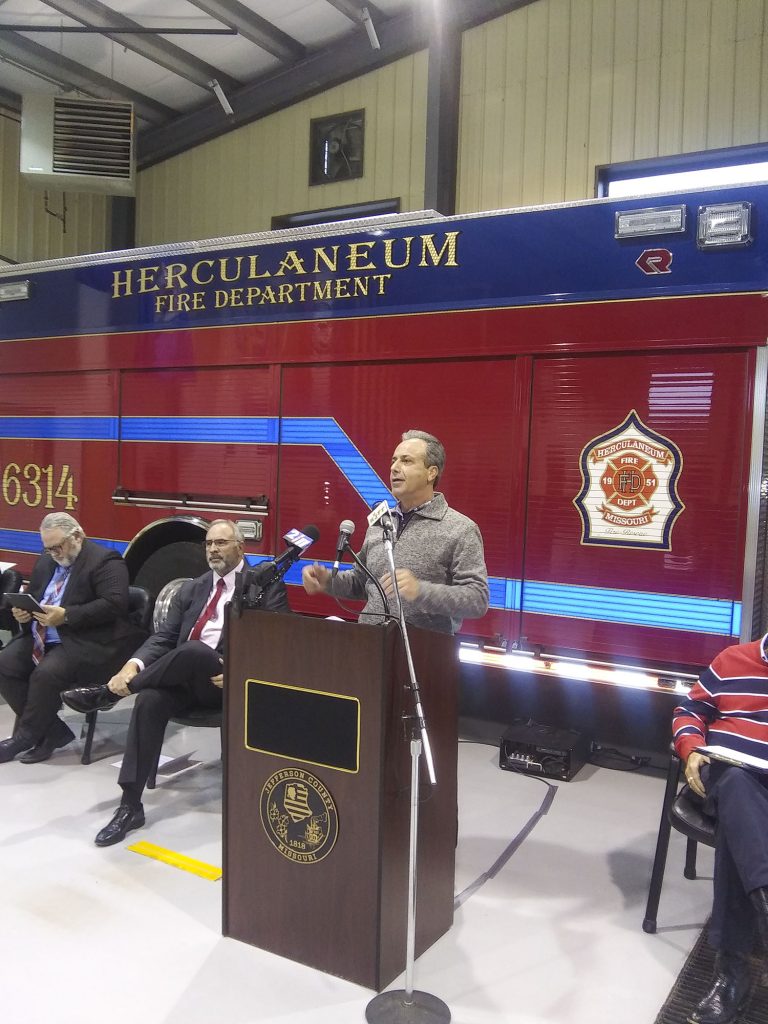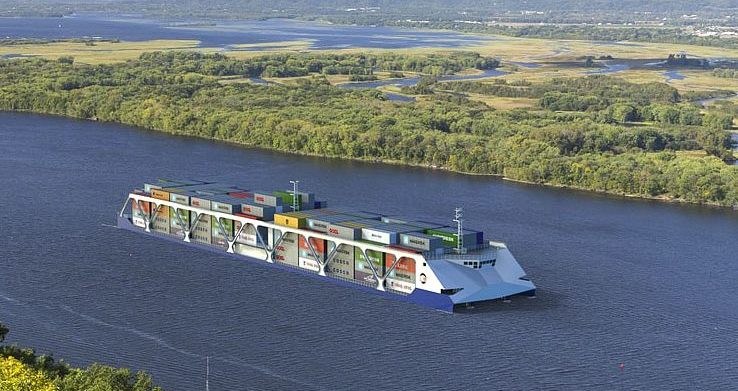Sal Litrico, CEO of American Patriot Container Transport LLC (APCT), made a long-awaited announcement December 17 at a press event in Herculaneum, Mo. Litrico, whose company is developing the patented new vessels that will carry containerized cargo along the Mississippi, Illinois and Missouri rivers, revealed that APCT has issued a solicitation to seven U.S. shipyards for construction of four of the patented container vessels that will provide the new container-on-vessel (COV) service, and an option for four more. The call for submissions was issued December 14 and proposals are due at the end of February, he said.
Litrico also announced new partnerships for the COV venture to develop a new container port at Herculaneum with a target operational date of the fourth quarter of 2024. “We came here with a vessel design that is revolutionary,” Litrico said. “We wouldn’t be here without your support.”
Vessels
The patented APCT vessels will be built in two sizes with the larger “liner” vessel, with a capacity of 2,375 TEUs, traveling between the gateway terminal in Plaquemines and the Mississippi River ports in Memphis, Tenn., and the new port facility in Herculaneum. The smaller “hybrid” vessel will have a container capacity of 1,800 TEUs and is designed to move through locks and low-lying bridges on the tributary rivers, providing service from those two primary Midwest ports to feeder ports along the Mississippi, Missouri and Illinois rivers in the St. Louis region and other upstream ports, including ports in Kansas City and Jefferson City in Missouri and in Joliet and Cairo in Illinois and Fort Smith in Arkansas.
Both vessels are designed with a patented “exoskeleton hull structure” designed to limit the vessels’ lightship weight to maximize cargo payload. The second patented feature is the “minimal wake bow structure,” which reduces hull resistance enabling upriver speed of 13 mph. with minimal wake.
Expected round trip times to Memphis will be six days and St. Louis in 10 days, faster than traditional barge tows, according to the company. The vessels will also be environmentally friendly, utilizing LNG (liquefied natural gas) power, and cargo-flexible with ability to carry a diversity of cargo, including refrigerated containers.
Designing Trade Route
In outlining the long journey toward container-on-vessel to the audience, Litrico explained that early on, his company realized it wasn’t enough to simply build the vessels; it had to pioneer and develop a whole new trade route, forming partnerships to make it happen. The latest of those partnerships was announced at the event.
The announcement about the new Jefferson County facility follows news of other recent milestones that are helping to move the new COV service closer to reality. In August 2020, American Patriot Holdings and Plaquemines Port Harbor & Terminal District in Louisiana announced they had signed a letter of intent to develop a multimodal, state-of-the-art container terminal at its facility near the mouth of the Mississippi River, to be the gateway port for the new COV service. APM Terminals North America was recently announced as the Container-on-Vessel terminal operator for the gateway port and is working with global shippers to integrate this proposed new logistics system with Midwest manufacturers and producers.“The Plaquemines protected riverport location and export/import market strength, coupled with the strategic middle-America location of the Herculaneum port in the St. Louis region, makes this a very unique supply chain offering for customers and our growth ambitions,” said Brian Harold, managing director of APM Terminals. “We look forward to working with all of the partners involved and with state and local leaders to ensure both ports are set up for long-term success.”

“The new partnerships being forged today and the advancements we’re making toward construction of the new vessels represent another huge step forward for this unique supply chain option that will reduce transportation costs for shippers by approximately 30 to 40 percent,” Litrico said. “The Mississippi River is ice-free and lock-free from the St. Louis region all the way south to the Gulf Coast, enabling us to bring our new vessels with the capacity to carry 2,375 20-foot-long by 8-foot-tall shipping containers right into the heart of the Midwest, and this new port facility will be developed specifically to be able to handle those vessels and containers.”
Lead Developer
Hawtex Development Corporation is signing on as the lead developer for the new COV port facility in Jefferson County, to be developed in collaboration with Fred Weber/Riverview Commerce Park LLC and integrating a 300-acre adjacent parcel owned by The Doe Run Company. Hawtex, a business development and consulting company with operations in Texas and Hawaii, has been working with American Patriot Holdings over the past several years to help in identifying and establishing market-ready locations for Mississippi River intermodal container facilities, with an initial focus on the Memphis and St. Louis regions. In the St. Louis region, the Herculaneum site emerged as the most advantageous site to develop a state-of-the-art intermodal container facility to serve this central Midwest region for both the export and import of containerized cargo.
“Through this new collaboration with our partners here in Jefferson County, Hawtex is looking forward to leading the development team for the planned facility on the Mississippi River at Herculaneum,” said James Hurley, president of Hawtex. “We will be leading discussions with RCP and The Doe Run Company principals to complete a comprehensive Development Agreement beginning early in the new year, and we will be meeting with and confirming service requirements for a number of St. Louis-based and regional beneficial cargo owners throughout Q1 of 2022. Our goal is to bring this facility to operating status in Q4 of 2024.” The total amount of the investment to be made at the new port is yet to be determined.
Supply Chain
“Given the supply chain disruption we’ve seen over the past two years and the continuing congestion at the West Coast ports, there is no question that shippers need alternatives,” said Mary Lamie, executive vice president of Multi Modal Enterprises for Bi-State Development and head of the St. Louis Regional Freightway, which has been building relationships with other Midwest ports over the past few years to help advance the COV initiative. “This is a new option to transport freight. The state of Missouri and the St. Louis region already play a critical role as a reliever during supply chain disruptions and our freight advantages are fueling this new opportunity to elevate the Mississippi River and the Missouri River’s role in global trade.”
Litrico told The Waterways Journal that greater corporate interest in low-carbon and carbon-friendly solutions, as well as recent public attention to supply chain issues, had helped boost interest in APH’s endeavor.
Mark Denton, vice president of Fred Weber/Riverview Commerce Park, said, “When Fred Weber Inc. set out to start Riverview Commerce Park in 2013, our CEO, Doug Weible, told me that we would be handling containers here someday. While Doug has always had great foresight, I don’t believe even he could have envisioned what the APH team has put together with these amazing new vessels that will revolutionize the container shipping industry, not just in the Midwest, but throughout the world.”
Caption for top photo: American Patriot Container Transport has issued a solicitation to seven shipyards for bids to build four patented vessels to carry containers on the U.S. inland river system.



